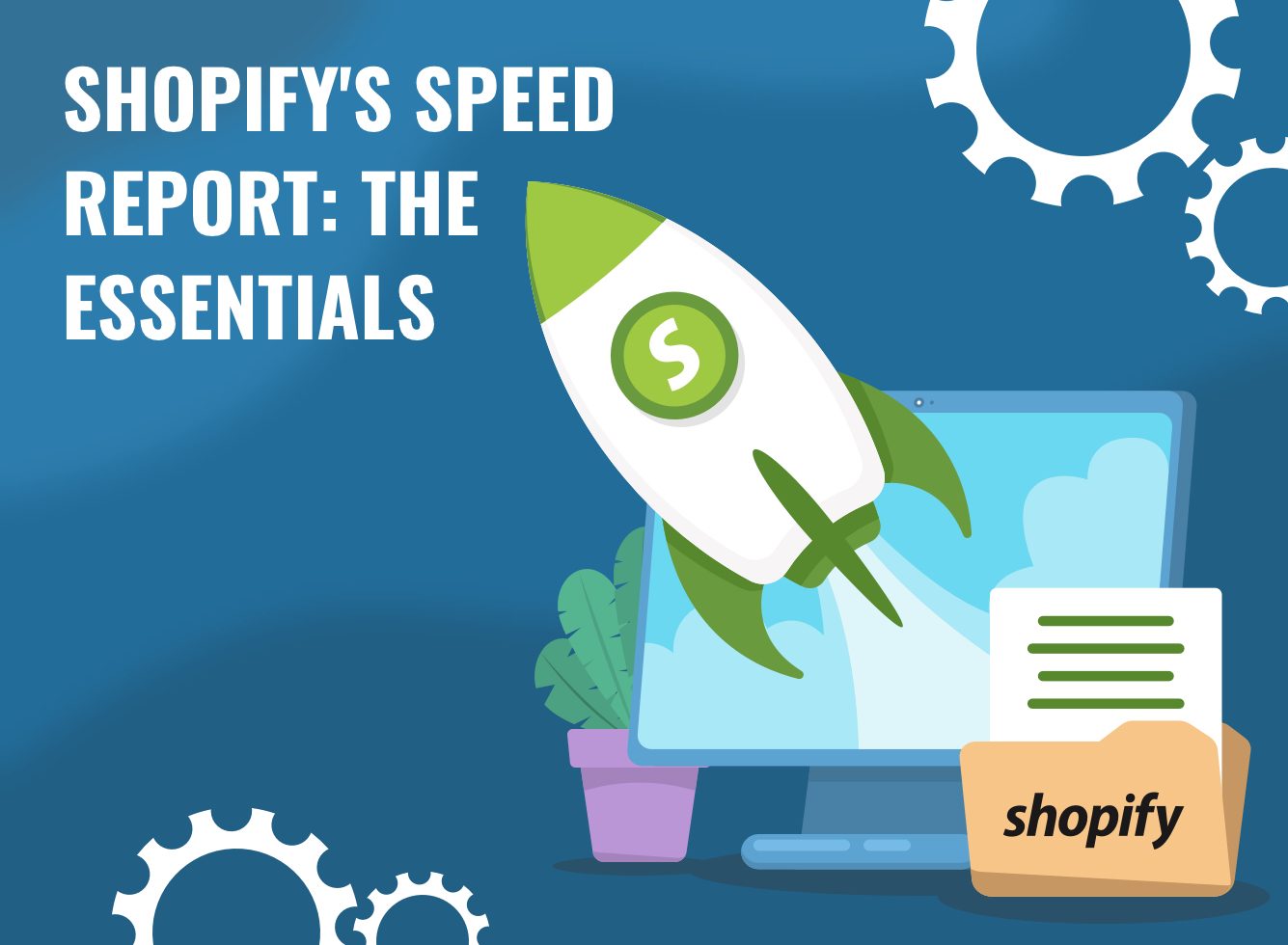Shopify’s Speed Report: The Essentials

A good site speed is crucial for eCommerce success. It boosts conversion rates, increases the likelihood of customers returning, has a direct impact on your sales, and is favored by Google when it comes to search ranking factors.
So, if you want to propel your online business in the right direction, it’s helpful to understand online store speed reports on Shopify to improve your positioning. We break down all the essentials you need to know in the article below.
Identifying Your Speed Score
Before you take any steps to improve your Shopify site speed, you need to know what your website’s score is in the first place. Depending on which platform or device you’re using, there are a few different ways to view your Shopify speed report.
Desktop
From your desktop, log into your Shopify admin account. Go to the Online Store and click Themes. Here, you should see a section titled Online Store Speed Score. By clicking this, you can see your speed score and even compare it with competitor online store speed reports on Shopify.
iPhone
Open the Shopify app and click Store. In the Sales Channel section, click Online Store, followed by Manage Themes. Here, you will see a section called Online Store Speed Score. Click this to view your speed score and View Report for the full report.
Android
If you’re using an Android, open the Shopify app. Click Store and head to the Sales Channel. Click Online Store and then Manage Themes. Open the Online Store Speed Score section to view your score. For the full report, click View Report.
Speed Score Calculations
A Shopify speed test measures how fast your website loads and performs for your customers, providing a total value out of 100. Your overall score isn’t just determined by this but also how fast your store performs, based on Google Lighthouse metrics.
For Shopify stores, three pages are tested — the home page, best-performing product page, and best-performing collections page. A score is then calculated based on the weighted average of these pages over the last seven days. If you don’t have one of these pages, the score for that page will be listed as ‘No data available.
It’s completely normal for your site’s score to fluctuate as it’s based on several factors, including website traffic. Even adding features and images to your pages can impact the score. If your store is new, or you’ve recently removed a locked password page, your score could be less accurate. But it’s important to note that it’s rare to achieve a perfect score of 100.
With 60% of sales on Shopify made from mobile devices, Google Lighthouse reports are run and created on the mobile versions of your pages, which is why it’s so important to prioritize the mobile friendliness of your site. By identifying your score, as mentioned above, and then clicking on the report, you can see how your score is calculated and identify any areas for improvement. This is essential if you want to maximize your business position in your market online.
Understanding Your Ranking
Another important tool for eCommerce business owners is the speed score ranking, which highlights how your speed score compares to your competitors — or at least similar eCommerce stores. When we talk about similar stores, we’re talking about those online sites that have the same products, sales volume, apps installed, or even themes used. Remember, if your peers take steps to improve their site speed, and you make no changes to Shopify speed Optimisation, your speed score could decrease.
Faster than similar stores
If you see this ranking, your speed score has been calculated at a higher number than other online stores, which means your customers are likely to be having a better buying experience.
Same speed as similar stores
For those businesses that have a similar online speed, it means your site is loading at roughly the same speed as others in the market. It’s not deemed particularly fast or slow and you’re offering a similar buying experience to your consumers.
Slower than similar stores
As the name suggests, this level of ranking indicates that your online store isn’t performing as well as it should be and is taking longer to load compared to competitors. In this instance, you should consider making a few improvements to boost your customer experience.
The Cause of Slow Site Speed
Now you know what site speed is, how it’s calculated, and how you can use it to determine your position amongst your peers, it’s time to look at exactly what impacts your Shopify store speed.
Apps
Adding apps and enhancing existing app features is a natural step as your business grows and a great way to boost user experience. However, it can also impact how fast your store loads and functions. This is because an increase in Shopify apps requires more time for the apps to communicate to the server.
Third-party libraries and services
Unused third-party services can also reduce your Shopify site speed, which is why it’s important to disable and remove any that you don’t use. Some third-party services even give you the option of disabling certain features so you can still have the service on your site but won’t be restricted because of unused features. This is a great tactic to speed up your Shopify site.
Analytic libraries
Analytics libraries give you detailed insights and data on the condition of your market to help you make smarter business decisions. But it’s important to only analyze the information that your business requires. Without doing this, your online store will be holding a huge amount of irrelevant information and slowing your site speed down.
Theme code
Some Shopify development themes have been found to significantly slow down overall site speed. This is because certain design elements can take longer to load and use up more of your site’s capabilities. One of the best ways to avoid this is to choose a Shopify theme that suits your website’s needs and ensure you keep it up to date with improvements and bug fixes.
Images and videos
Large images and video content are another reason for slow site speed. In short, the more you add and the larger the files, the slower your website begins to function and load. That’s not to say that you shouldn’t use them — in fact, they’re essential for eCommerce websites. However, to increase your Shopify site speed, you do need to properly optimize files to reduce the impact.
Let our Shopify Development Company Improve Your Site Speed
Shopify store owners who really want to level up their eCommerce site in 2023 and beyond should focus on improving their site performance. When your site loads faster, you’re better positioned to increase brand awareness, boost your rankings in search engines, and improve customer satisfaction.
Latest figures even show that Google, which is the most popular search engine and owns over 92% of the world’s market share, prioritizes site speed when ranking sites. So, if you’re looking for ways to level up your online store speed, it pays to take a look at the Shopify speed report.
Not sure where to start? You could also hire experienced Shopify developers like Vsourz. Simply get in touch with our Shopify development agency and let us take care of everything.






